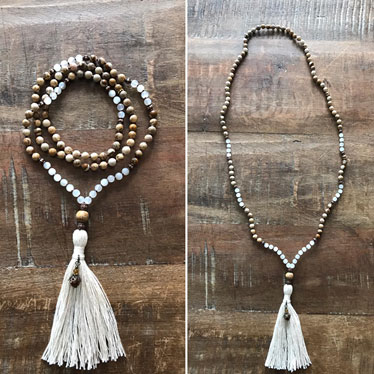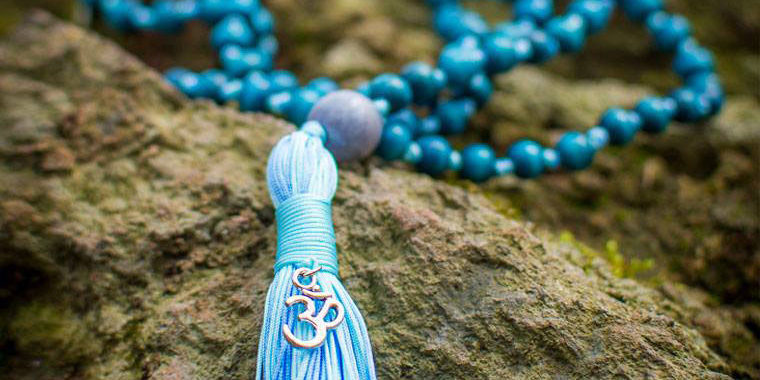Menopause is a personal transition period that can be difficult, but it also should be considered a time for personal reflection. It is a phase where the benchmarks and values adopted so far may undergo changes. Adopting a clear attitude that allows us to discern between what works and what no longer works, can provide ease in this process, and help us to avoid quality of life changes.
Meditation is considered very effective in reducing stress, a factor that decisively contributes to the symptoms of menopause.
A technique used since ancient times to be able to meditate is the use of the JAPA MALA, and this is what I am going to focus on today. The JAPA MALA is a necklace of beads that serves to count the repetitions of mantras or affirmations during meditation. The counting of beads helps to keep the mind focused, thus avoiding distractions caused by our surroundings.
Originally, it comes from Ancient India and its meaning or etymology derives from the Sanskrit JAPA, which means to murmur and MALA which means garland or necklace.
The recited mantras or phrases are considered to have a sacred meaning and serve to create a state of consciousness.
This tool traditionally used by Buddhists can be compared to the Christian Rosary or also to the Islamic Tasbih.
How is a Mala meditation done?
The mala is a necklace of 108 beads, round to facilitate the transition between the fingers of the hand. These beads represent the Universe and are individually knotted, with a cord that symbolizes the universal being that holds together each part and each being of the Universe.
The number 108 has different meanings such as: 27 constellations (for 4 parts); 12 houses of the zodiac (for 9 planets); 108 Upanishads or sacred scriptures of the Vedas.
The mala also has an additional bead called Guru, knotted in turn to the rest of the beads, and considered as the representation of the Universe itself, the supreme force. This bead is at the beginning of the necklace, from which the tassel hangs. The tassel symbolizes the energy created during meditation.
The circular arrangement of the beads signifies the infinite cycle of birth and death. The knots between the beads ensure the beads do not touch during meditation and therefore avoid any distraction that may be caused by the sound of the beads rubbing as you repeat the mantra and move from one bead to the next.
The malas are always made with round beads, usually between 8-10 mm, to facilitate sliding between the fingers.
Types and styles of Mala Meditation
Traditional malas are made with Rudraksha seeds, yak bone, lotus seed or wood. But we can also find malas made with semi-precious stones which are considered healing malas for their properties of energy and color.
Bracelet malas can also be used for the same purpose, with 21 or 27 beads.
How to use a mala to meditate
At first, you should set the intention of your practice and choose your mantra or affirmation. Then find a comfortable space and sit quietly cross-legged. Close your eyes and observe the speed and depth of your natural breathing. Begin to breathe deeply and focus your attention on the mantra or affirmation. Then, dangle the first bead lightly on the middle or ring finger of the right hand while keeping the index finger pointing outward, as an indication that our ego is moving away from us during chanting or repetition. Since the index finger symbolizes our ego, make sure it does not touch the mala. Place your thumb on the guru’s bead and begin reciting the mantra.
At the end of each repetition or mantra, push the bead with your thumb and move to the next bead for another repetition.
You can count and chant 7, 21, 27 or 108. And if you want to do another round of mantras or affirmations, start over but never bypass or skip the Guru bead. Instead, turn the mala and start counting in the opposite direction.
Finally, for an affirmation or mantra to gain strength and take root, using a mala (garland), you have to do Japa Mala 108 times for 40 days in a row.
How to choose your Japa mala
The material of the beads depends on the purpose of the Japa Mala. For these moments of transition, the properties of certain gems, stones or materials, even colors are effective:
- Moonstone: Stimulates hormonal balance, relieves the discomfort of menopause and regulates the functioning of the thyroid. Strengthens the immune system in general. Seek inner growth, live in harmony and with creativity. Stimulates love and sensuality.
- Coral: Helps in osteoporosis treatments, stimulates the growth and formation of healthy tissues. Improves circulation and prevents the loss of energy. Strengthens the blood. It symbolizes joy and happiness. Strengthen love and the need to share life with a love. Protects against negative energies, such as envy and resentment.
- Sandalwood: Calms the mind and encourages concentration, leaves a very pleasant scent on the hand after meditation.

Japa Mala is a powerful instrument to meditate the chosen Mantra by allowing us to connect our own being with the Universe. This is the first step in acquiring clarity and in discerning how meditation can help us with the transition process in which we are navigating.
“Repetition is the persuasive strategy par excellence.”
For more information on the process of creating a Japa Mala and the materials visit my website.
Amparo Hernandez.
Meditation. Menopause. Mental Wellbeing. Spiritual.
If you enjoyed this article and would like to help us support this beautiful project so we can continue creating amazing content; please help us by donating as little as the cost of a coffee or as much as you like.
and






